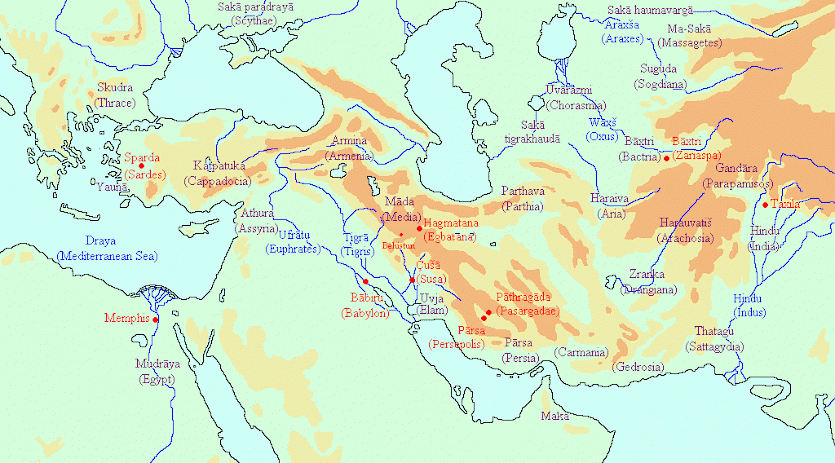Drangiana
Q1074810Drangiana (Old Persian Zranka, "waterland"): satrapy of the ancient Achaemenid Empire (Sistan in modern Iran). The country is a dusty and often stormy desert with sandy dunes, but there are fertile plains along the river Etymandrus, modern Helmand Rûd.

The Iranian tribe that the Greeks called Sarangians or Drangians was first subjected by the Medes. The new rulers were, however, overthrown by the Persian king Cyrus the Great (550 BCE). Just like its predecessor, the Achaemenid empire was very loosely organized: we can best imagine these two kingdoms as tribal confederations under a Median or Persian ruler.
The Drangians and other tribes in eastern Iran were related to the Medes and Persians, spoke the same language and had the same customs (e.g., the fire cult and the cult of the supreme god Ahuramazda). They will not have thought about the Persian rule as an occupation by a foreign power.
According to the historians who describe the campaigns of Alexander the Great, in Drangiana lived a tribe called Ariaspae. They were also known as 'the Benefactors' because they had saved the army of king Cyrus when it was crossing the desert.
Things started to change during the reign of king Darius I the Great (522-486). He organized the Achaemenid empire and divided it into twenty tax districts. According to the Greek researcher Herodotus of Halicarnassus (fifth century BCE), the Sarangians were placed in the same district as the Utians, Thamanaeans, Myci, Sagartians and those deported to the Persian Gulf.note
Except for the Thamanaeans, who are otherwise unknown, and the Myci, who lived in Oman, these tribes can all be found in Central-Iran. In later texts, the Utians are mentioned in the Zagros mountains north of the Persian capitals Persepolis and Pasargadae, but it is possible that in the sixth century BCE, they lived a bit more too the east.
The Persians founded a capital among Drangians, which was called Phrada and may be identical to modern Farâh or the Achaemenid palace that was excavated at Dahan-i Ghulaman (near modern Zabol). Slowly, the region must have changed: it had been a tribal society of cattle drivers, but the Drangians became farmers and many people started to live in villages. One of the new economic activities was the extraction of tin, which is used to make bronze. Centuries later, the Greek topographer Strabo of Amasia was to write that the Drangians were persisontes, which probably means "had become like Persians".note
The process of change must have been finished before the age of Alexander the Great, who arrived in Drangiana in November 330 BCE. What he found was a well-organized province of the Achaemenid empire, ruled by a man named Barsaentes, who was satrap of both Drangiana and Arachosia. Alexander appointed a new satrap, Arsames, and renamed the capital; it became known as Prophthasia, "Anticipation", because Alexander had here discovered a conspiracy against his life, said to be organized by his compagnion Philotas.
After the death of Alexander, his empire fell apart and his generals divided the countries he had conquered. Drangiana was fell to Seleucus I Nicator, the founder of the Seleucid empire. For more than a century, the Seleucids remained in control of the region. There is some evidence that is was in Drangiana that the adherents of the religion founded by Zarathustra came together to re-establish their faith and sacred text, the Avesta (more).
At the beginning of the second century, Bactria made itself independent from the Seleucid empire. Their leaders, who considered themselves to be Greeks, tried to conquer adjacent territories, and c.184 they seized Gandara and Drangiana. The Graeco-Bactrian overlordship did not last very long: after a generation, Drangiana was conquered by the Parthians. It was put together with Aria in one tax district. The Parthian reign did not last very long either: in 128, the country was taken over by the Sacae.
This is the usual name for the nomad tribes of Central Asia. They had always been kept away from Iran, but had ravaged the Graeco-Bactrian kingdom three or two years before. Drangiana became known as Sacastane, a word that has changed into Sistan, its modern name.